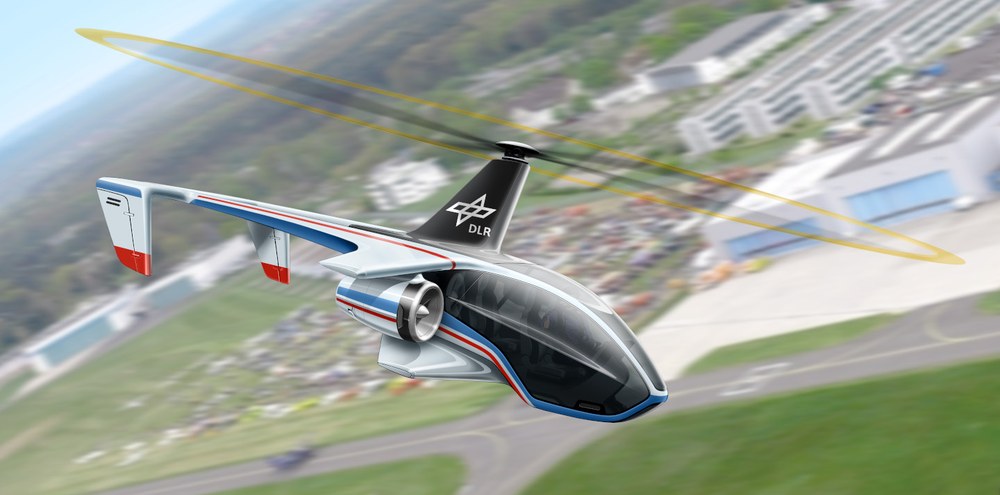S²TOL
Aims of S²TOL
We are already experiencing the increasing difficulties of travelling effectively in road traffic on a daily basis. Traffic jams, lack of parking spaces or construction work not only cause heated tempers, but above all increased environmental pollution and noise. Conventional alternatives are already showing that they alone cannot cope with this development in the face of rising population growth, increased migration to metropolitan areas and an increase in delivery traffic. Nevertheless, in order to significantly reduce intra- and interurban travel times for passengers and goods in the future, urban and interurban air traffic is expected to take an ever larger and growing share of passenger and freight traffic.
The technical prerequisite for this is the development of innovative aircraft types that fulfil the special requirements in terms of flight performance, safety and noise immission. Various approaches already exist worldwide for new aircraft configurations that address the requirements of future urban air traffic. In particular, the aspect of noise and sustainability is playing an increasingly decisive role in this search. Aircraft, such as helicopters, which are currently the primary means of urban air transport, have the ability to operate in very small spaces, but are perceived as comparatively noisy at low altitudes. This is compounded by their high complexity and energy consumption, as well as the associated costs.
The most common form of propulsion is currently the combustion engine, which has a poor environmental balance and, in conjunction with the arrangement of the propellers, generates a high level of noise. As a more sustainable solution, the focus is therefore on switching to electric drives in conjunction with the reduction of propeller noise. At present, however, the question of flight performance requirements and the economic viability of new aircraft configurations has not been adequately answered. Therefore, in the S²TOL (Silent Short Takeoff and Landing) project, a new concept for an extremely quiet aircraft capable of short takeoffs is to be developed and demonstrated in flight experiments. The basis for this aircraft is a gyrocopter.
Gyrocopter as a basis
A gyrocopter is a rotary-wing aircraft in which the rotor is set in rotation by the incoming air. In contrast to the helicopter, the rotor is not driven by an engine, but is in a so-called autorotation state during the entire flight. The freely rotating rotor blades eliminate the need for a complex main rotor gearbox. This significantly reduces the manufacturing and operating costs of a gyrocopter. In addition, its maneuverability and short takeoff and landing distances - steep approaches and departures are possible - are among the other urgently required characteristics for use in urban areas.
Certification of the gyroplane configuration
Currently available gyrocopters can only be found in the class of ultralight sports aircraft. Type certification is only granted in accordance with national law and is regulated in Germany by the "Bauvorschriften für Ultraleichte Tragschrauber" (BUT) of the Luftfahrtbundesamt (LBA). The certification of a new aircraft configuration is a very complex and time-consuming process. Therefore, another focus of the project is the research of a data-based verification of airworthiness requirements. For this purpose, existing airworthiness directives and guidelines are to be analyzed and integrated into an aviation-approvable fiber composite process chain.
At the end of the S²TOL project, this novel approval chain is to be demonstrated using the example of the complex fiber composite structure of an engine nacelle. The airworthiness certification is to be performed without accompanying samples; as a result, for example, the degree of curing is to be determined by sensors coupled with numerical models.
Research focus Urban Air Mobility
The aim of the project is to evaluate a new gyrocopter configuration in terms of flight performance, safety and noise immission in flight tests and to derive new airworthiness requirements with a view to future EASA certification. Thus, the focus is on the development and testing of technologies designed to reduce noise emission as well as optimize flight performance. The use of electric propulsion systems in combination with two large free-flow propellers or two ducted propellers is being investigated to reduce noise emissions and improve sustainability.
The project focuses on flight testing using two demonstrators with a take-off mass of approximately 400 kg. Flight testing will be unmanned, and the demonstrators will be equipped with batteries, electric motors, actuators and a complete flight system control. The construction and flight testing of the demonstrators will generate unique measurement data that will contribute to new scientific findings.
The vision is a quiet, high-performance gyrocopter with EASA certification. As part of the S²TOL project, all the necessary fundamentals with regard to structure, manufacturing technology and flight mechanics for certification are to be defined, researched and tested.
Project data | |
|---|---|
Term | 3 years |
Participating institutes | |
Partner | RWTH-Institut für Strahlantriebe und Turbomaschinen |

